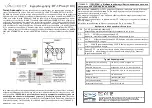
Operating Manual CMGZ 622
5
2
Definitions
Offset:
Correction value for compensation of the zero point difference. Thanks to the
offset, it is ensured that a force of 0N will generate a signal of zero exactly.
Gain:
Amplification factor for the measuring signal. Use of an appropriate value will
adjust the force sensor signal to the material tension feedback value exactly.
Strain gauge:
Electronic component that will change its resistance while its length
has changed. Strain gauges are used in the FMS force sensors for acquisition of the
feedback value.
Subprint:
Electronic extension module which can be plugged in to the main board of
the electronic unit if required. That way, the possibilities of the electronic unit can be
extended easily.
Channel:
The analogue inputs and outputs of a subprint, used for a certain purpose.
There can be up to four channels in a single electronic unit.
Module:
The software running on the microprocessor is spread over various function
units (modules). A module can be used multiple times, i.e. when two measuring points
are operated, the module „measuring amplifier“ is used twice. Each module has its
own parameters and special functions.
Pilot control:
If pilot control is activated, a reel diameter signal (from a distance
sensor, PLC or similar) is taken into the calculation of the drive power and the drive
will be „pilot controlled“ with the calculated value. Then, the controller has only to
control the variation of the material tension. Due to that, the stability of controlling
will be improved.
Single quadrant and four quadrant drive:
Expression refers to the speed/torque
diagram used in the drive technology. A single quadrant drive can only drive in
forward direction; a four-quadrant drive can both drive and brake in forward and
reward direction.






































